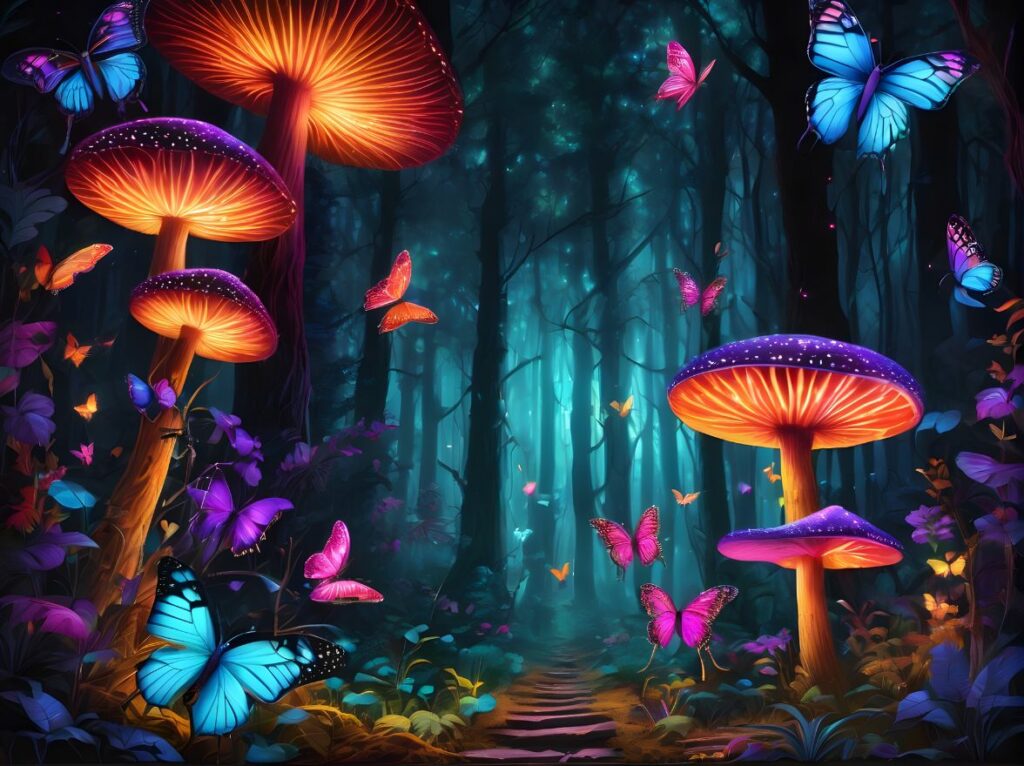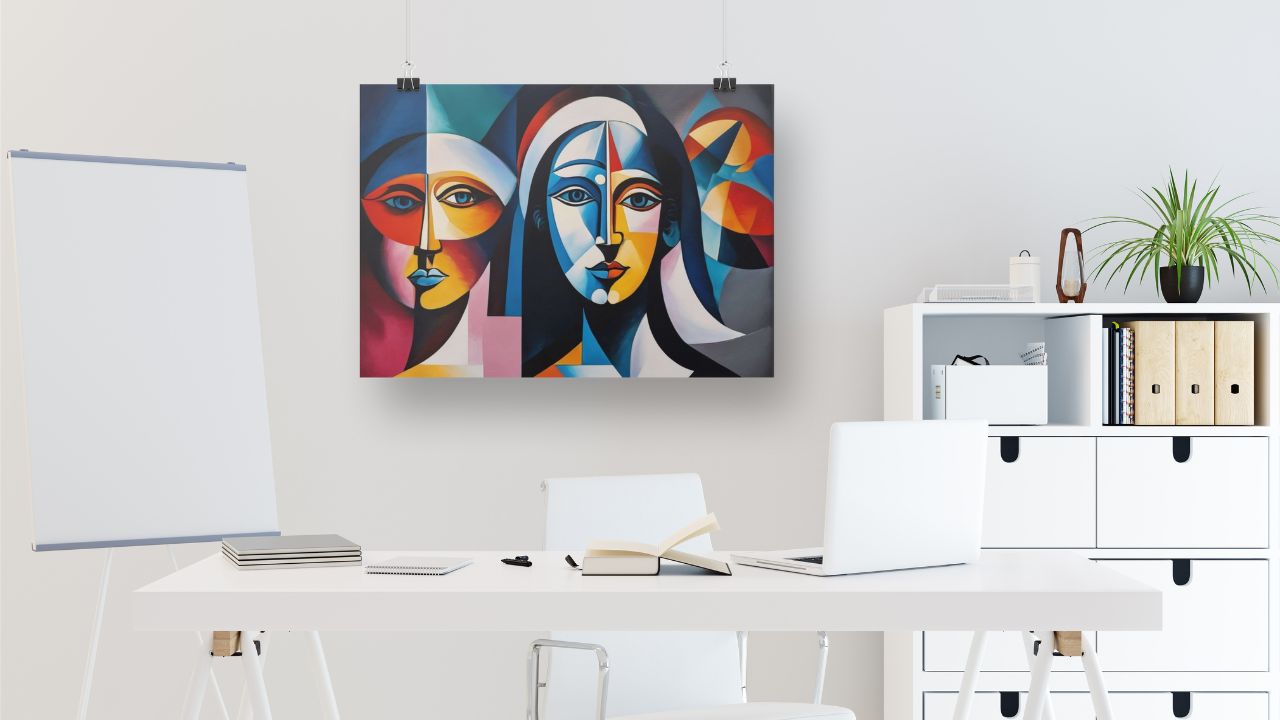Thanks to numerous AI art generators, artists and enthusiasts can skillfully blend technology and expression to craft mesmerizing pieces. As the fascination with AI art continues to soar, it’s equally important to know how to bring these digital wonders to life through printing.
In this post, discover how to prepare your AI-generated images, turning them into exquisite prints!
What are AI art prints?
An AI print is a visual creation produced by printing artwork generated through computational processes, specifically using artificial intelligence (AI) algorithms. The foundation of AI art lies in machine learning algorithms, which study extensive datasets of images, sounds, or various types of data. The algorithms leverage this acquired knowledge to craft entirely new and distinctive artistic pieces.
How are AI art prints generated?
Users can input creative prompts, like “a mystical forest with neon butterflies and mushrooms illuminating the night,” into text-to-image generators.
These prompts undergo a transformation, being mapped onto a representational space and compared with existing captions and alt text to uncover related imagery. Following this, a diffusion process introduces noise while reducing complexity. The generator then ingeniously reverse-engineers from these elements, crafting an image that aligns with the original text prompt, resulting in a creation you can readily recognize.
AI art generators utilize machine learning to source imagery, treating it as raw material to construct something new. Noteworthy AI art generators in this creative landscape include DALL-E 3, Midjourney, Stable Diffusion, and Img2Go’s AI Art Generator, among many others.

– Created with Online Convert’s AI Creator Studio.
STEP 1: AI Image Upscaling
Creating high-quality AI art prints with sharp details requires starting with a high-resolution AI file for printing. Many AI art generators create images with low resolution – making them unsuitable for printing due to potential pixelation and loss of detail. The solution lies in utilizing an AI image upscaler.
Just as AI art generators leverage machine learning to craft digital masterpieces, an AI image upscaler relies on computational predictions to enhance image resolution. By adding the necessary pixels during the upscaling process, the image upscale tool ensures the generation of a high-resolution file without the drawbacks of pixelation.
So, remember to enhance the visual appeal of your AI-generated images by upscaling them before printing for a stunning outcome!
STEP 2: Choosing the Right Format for AI Art Printing
TIFF (Tagged Image File Format) is widely preferred for printing due to its lossless compression, making it particularly suitable for professional printing where precision and clarity are paramount.
For easy conversion to TIFF, JPEG, or other print-friendly formats, consider using Online Convert‘s – Image Converter.
This tool simplifies the conversion process, enabling you to transform your digital creations into image formats that align with your requirements.
STEP 3: Optimizing Your AI Print File – Best Practices
After upscaling your AI art, also consider:
- Resolution: Aim for a minimum of 150 DPI for optimal AI printing quality.
- Embed ICC profiles: Crucially, embed ICC profiles in the image file. Consider Adobe RGB (1998) for artwork and sRGB IEC61966-2.1 for photography.
- JPEGs: Although JPEGs can be submitted in CMYK, it’s recommended to save them in the RGB color space for optimal results.
- Printing in different sizes: AI-generated art prints can be produced in various sizes, limited only by the resolution of the AI file for printing. A guideline of 150 DPI helps determine potential print sizes based on the print file.
- Aspect Ratio: Consider the aspect ratio, and be mindful that cropping may impact the subject content of the AI art print.
- Test Prints: Before committing to a large-scale print, consider producing smaller test prints to evaluate color accuracy, sharpness, and overall quality.
PRO TIP: Utilize graphic tools like Photoshop, Affinity Photo, or similar programs to finely adjust color balance, contrast, saturation, and overall composition, ensuring a polished and professional appearance before printing your AI-generated images.
Some AI-generated images may contain objects or irregularities that can be easily edited or removed using graphic software. If you’re not proficient with these tools, try user-friendly online options like Canva.
In Conclusion
The journey from digital creation to stunning print is both exciting and nuanced. By embracing the tips outlined in this post, you’ve unlocked the potential to transform your AI masterpieces into tangible works of art!
Every step plays a crucial role in enhancing the overall quality of your prints. Focus on resolution, color profiles, and aspect ratios, ensuring your AI-generated images are finely tuned for a seamless printing experience!
Now, apply the insights gained here, from upscaling to editing, and witness your AI artwork come to life in the form of captivating prints!
FAQ’s:
1 Can I Sell AI-Generated Art?
Selling AI-generated art mirrors the process of selling traditional art prints and can be done on established platforms like Etsy, Amazon, various retail locations, and dedicated AI art marketplaces.
It’s important to carefully review the terms of use associated with the specific AI image generator you utilize to ensure you possess the necessary commercial rights for the generated images, as these terms may differ across different generators.
2 Is a Square Image Suitable for Printing?
If you’ve generated a square image (aspect ratio 1:1), be aware that it may present some challenges for printing due to potential difficulties in proper cropping. Consider the following steps to enhance the printability of your square artwork:
- Upscale for Details: Before further processing, upscale the image to a minimum of 5000 pixels to ensure enhanced details, preventing blurriness, and optimizing overall print quality.
- Refinement with Graphic Software: Following the upscaling process, consider additional refinement using graphic software.
- Consider Audience Preferences: Keep in mind that while some individuals may appreciate square images, the majority tend to prefer landscape or portrait orientations. Offering options can broaden the appeal of your artwork, especially if you plan to sell prints.
3 How Can I Use AI-Generated Art?
AI-generated art can be used for a multitude of purposes! Craft personalized avatars, enhance game asset development, and create visually stunning content for blog posts, presentations, websites, and social media. The possibilities are endless, whether you’re seeking inspiration for your artistic endeavors or adding brilliance to your digital marketing campaigns!

